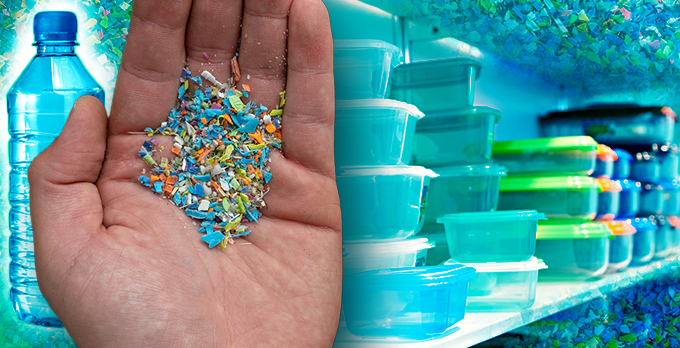Many people are talking about microplastics- the tiny plastic particles less than five millimeters in diameter, and how pervasive they are in the environment, so much so, that they are being found throughout the human body. University of New Mexico Health Sciences researchers have discovered microplastics in the brain, in testicular tissue, and even in the womb. The information may be daunting, but one researcher in the UNM College of Population Health believes there are some things you can do to help reduce some exposure to microplastics.
Plastics in the Environment
Plastics are everywhere. At every stage of the manufacturing process, from the extraction of oil and gas to making plastics to discarding them, toxic chemicals are released into the environment. On average, single-use plastics are utilized for only 12 minutes before being discarded. Although briefly used, those single-use plastics will persist in the environment for generations in landfills and waterways, breaking down and degrading over time ultimately becoming microplastics that do not disappear. As they become smaller, they enter our food chain.
Plastics are also found in oceans, lakes and streams. The particles can become so small and light that they can attach to dust and move about in the atmosphere. They can be carried by wind and rain, spreading all over the earth, even to places that seem clean and untouched by pollution. To further the contamination issue, water treatment plants, which clean our water, are not capable of filtering out microplastics. Most plants were built in the early 1900s, prior to microplastics research. After multiple studies since then, it’s been revealed that those plants are not capturing microplastics at all, because they were never designed to deal with them.
Human exposure to microplastics occurs through various pathways: ingestion of food and water that contain microplastics, inhalation of airborne particles, and dermal contact. The health risks associated with microplastics are still under investigation, but potential concerns include oxidative stress, neurotoxicity, reproductive toxicity, altered immune and endocrine functions, and an increased risk of heart disease.
Claudia Pratesi, PhD, with the UNM College of Population Health has been studying plastics in the environment for the past decade.

If the environment is sick, animals will become sick, and consequently humans will be sick as well.
She cited recent studies that state that depending on diet and lifestyle, individuals can ingest up to five grams of microplastics per week, equivalent to the weight of a credit card. However, she said there are things we can do to lower our exposure.
- Drink Tap Water: If you have the choice, drink tap water instead of plastic bottled water. If you can, use a water filter or reverse osmosis filtration system, which can help remove some plastics.
- Avoid Heating Plastics: Do not heat up or microwave food or drinks in plastic containers (including infant formula or pumped human milk). This causes chemicals to leach out and into foods. Use glass or ceramic containers instead.
- Choose Safe Storage: Use glass, ceramic or stainless-steel containers for storage. If they have plastic lids, make sure the food doesn’t touch the lids.
- Eat Whole Foods: Eat fresh, whole foods and meals made from scratch. Highly processed foods, such as canned food, junk food, and premade and partially premade foods, are more likely to be exposed to plastic in processing and packaging.
- Buy Local: Buy from local food producers. Eat fresh fruits and vegetables, and if you eat meat, avoid plastic wrapping.
- Avoid plastics with these recycling codes and labels:
- Code 3: Contains phthalates - a known carcinogen
- Code 6: Contains styrene - affects the central nervous system
- Code 7: Contains bisphenols A, S and F - known endocrine disrupters and have obesogenic effects
- BPA-Free: Still contains Bisphenol, and is used in can linings, plastic utensils, and on sales receipts
Ultimately, the key is to avoid having the foods and drinks you ingest come in contact with plastics at any point prior to purchasing, during cooking or storing.
“Remember, we vote with our dollar,” Pratesi said. “If we continue to go out and buy plastic containers and use plastic bags, and we never look for alternatives that are not toxic or bad for our environment, corporations will continue producing more plastic.”
Because not everyone knows about the dangers of microplastics or has the money to buy safer alternatives, Pratesi said it's important to spread awareness and find equitable solutions that everyone can use. There is an urgent need to mitigate environmental hazards that contribute to health disparities and chronic diseases. This includes advocating for policy changes that reduce plastic use, improve waste management, and protect vulnerable populations from exposure to harmful pollutants like microplastics.
